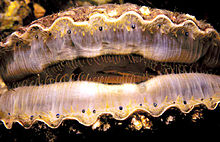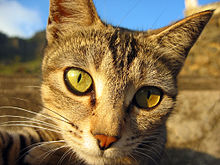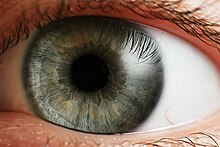eye

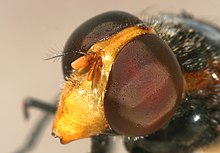

The eye ( ancient Greek ὤψ ops , Latin oculus ) is a sensory organ for the perception of light stimuli . It is part of the visual system and enables animals to see . The stimuli are picked up with the help of photoreceptors , light-sensitive nerve cells, whose state of excitation is changed by the different wavelengths of electromagnetic radiation from the visible spectrum . In vertebrates , these nerve impulses reach the visual center of the brain via the optic nerve tract , where they are ultimately processed into an optical perception .
The eyes of animals differ considerably in structure and functionality. Their performance is closely adapted to the requirements of the respective organism. The number of eyes is also an evolutionary result of living conditions. Some animals, whose orientation is less determined by visual impressions, only need a rough distinction between light and dark, while others need contrast and movement patterns. More highly developed eyes are used for high-contrast image perception , the quality of which increases with the ability to perceive differences in brightness in a very differentiated manner ( minimum visible ). This in turn is expressed in a corresponding visual acuity ( minimum separable ), which can be very different by day, twilight or night. Still others need less contrast-rich vision than a large field of vision or differentiated color perception in different wavelength ranges .
With the degree of visual orientation the performance increases the visual sense of a life form - this is achieved by a finer anatomic structure and a growing complexity of neural connections, which the image forming and the image processing are used.
etymology
The Common Germanic word “Auge”, from Middle High German ouge from Old High German ouga , is based on the Indo-European root ok u̯ - “see; Eye ”(cf. synonymous Latin oculus ).
Evolution of the eye

(a) pigment spot
(b) Simple pigmented indentation
(c) of the eye cup abalone
(d) eye lens of marine gastropods
There are estimates that eyes of the most varied of designs were redeveloped around 40 times in the course of evolution . Nevertheless, the Pax-6 gene plays an initiative role in the early development of the eyes in cuttlefish as well as in mammals (mice) and insects. In the fruit fly ( Drosophila melanogaster ) the homologous gene eyeless has the same function. Therefore it stands to reason that all these types of eyes have a common origin. Orthologues of PAX-6 can be found in many chordates (ancestral origins in the Precambrian ). Fossil finds also show that there were early eyes as early as 505 million years ago in the Cambrian era (e.g. the pinhole camera eye of the pearl boats ). The first lenses had trilobites in compound eyes 520 to 500 million years ago.
Central properties
As a result of a visual stimulus processing the properties are direction See , visual acuity , field of vision , color vision , form vision and motion vision to name. The requirements of the respective life forms on these characteristics are very different. In addition, many species are able to adapt their eyes to different object distances with varying degrees of precision ( accommodation ).
Directional vision
Due to their anatomical and physiological development, some eye types are only able to identify the direction from which light falls on their sensory cells. This property allows only poor visual orientation, but represents a greater possibility of differentiation compared to the mere perception of light and dark.
Visual acuity
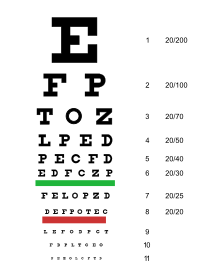
With visual acuity , the ability of a living being is called to recognize shapes and patterns in the outside world as such. Their quality depends on:
- the resolving power of the eyeball,
- the image quality on the retina, which is determined by the refractive media of the eye - cornea, aqueous humor, lens and vitreous humor,
- the refraction of the eye, as well as the refractive index of the medium that borders the cornea from the outside (air, water ),
- the optical properties of the object and its surroundings (contrast, color, brightness),
- the shape of the object: the retina and the central nervous system are able to resolve certain shapes (horizontal and vertical straight lines, right angles) higher than the resolution of the eyeball alone.
Various parameters have been defined for quantification. Angular visual acuity (angular visual acuity) is the resolving power at which two visual objects are still perceived as separate ( minimum separable ). The resolution of 1 '(one arc minute ) corresponds to a spatial resolution of about 1.5 mm at a distance of 5 m. The smaller the angular visual acuity, the better the visual acuity. The dimensionless property of visual acuity is defined by setting the reference value 1 'in relation to the individual angular visual acuity.
VA = 1 '/ (individual angular visual acuity)
The greater the visual acuity, the better the visual acuity. Example: if a person can only separate points at an angular distance of 2 ', he has a visual acuity of 0.5. Instead of angles, distances can also be determined. If you choose the distance d as the reference value, at which you can see two points at an angle of 1 ', then:
Visus = individual distance / d
Example: if a person can only see the points separated at a distance of 6 m, which have an angular distance of 1 'at 12 m, they have a visual acuity of 6/12 = 0.5.
Facial field

The field of vision is the area of the outside space that can be visually perceived with varying degrees of sensitivity with a calm, straight head posture and a straight, motionless gaze. A distinction is made between the monocular visual field of one eye and the sum of the visual fields of all eyes of a living being. Its extent is usually given in the unit of angle of vision and differs significantly depending on the living being. Examples of the extent of a horizontal field of view:
- Fly almost 360 ° ( compound eyes )
- Frog about 330 °
- Kestrel 300 °
- Crocodile 290 °
- Human 214 °
- Barn owl 160 °
- Snails ( bowl eyes and holes ) around 100 ° to 200 °
- Jellyfish and worms ( flat eyes ) 100 ° to 180 °, larger with multiple eyes
Color vision
Color perception is the ability to differentiate electromagnetic waves of different wavelengths in their intensity. This ability is common throughout the animal kingdom. The absorption spectrum of the perceived and distinguishable wavelengths characterizes the quality of this ability in a species-specific manner. For this, the perception system must have at least two different types of light receptors in order to be able to recognize the composition of the light.
Designs
The simplest “eyes” are light-sensitive sensory cells on the outer skin that function as passive optical systems. You can only tell whether the surroundings are light or dark. One speaks here of skin light sense.
Insects and other arthropods have eyes that are composed of many individual eyes. These compound eyes provide a grid-like image (not multiple images as one might assume).
In addition to the types of eyes described with refractive lenses, mirror eyes are also occasionally found in nature. In the scallop's eyes (Pecten) , the image is created by concave mirrors that are placed behind the retina. The lens located directly in front of the retina is used for the optical correction of the strongly distorted mirror image. The mirrors are built on the principle of reflective glass plates. More than 30 layers of the finest guanine crystals are densely stacked, each layer enclosed in a double membrane . Other animals also have mirror eyes , including the deep-sea crab gigantocypris , the lobster and the lobster . This form has evidently prevailed where the image quality is less important and the light output is more important.
Shaded photoreceptor
Some living beings, such as earthworms, have individual light-sensing cells at the end of their body or scattered about. Their position relative to the light-absorbing body of the worm determines the directions of light incidence to which these sensory cells are sensitive. This principle has already been implemented in the single-cell Euglena : The photoreceptor is here at the base of the flagellum and is shaded on one side by a pigmented eye spot. This enables the cell to move towards the light ( phototaxis ).
Flat eye
Jellyfish and starfish have many light sensory cells lying next to one another, which can connect to a layer of pigment cells on the inside. The concentration of the sensory cells in such flat eyes improves the light-dark perception.
Pigment cup eye
In pigment cup eyes, the visual cells are facing away from the light (inverse position) in a cup made of opaque pigment cells. The light can only penetrate through the opening of the cup to stimulate the photoreceptor cells. Since only a small part of the photoreceptor cells is stimulated, the direction of incidence of the light can be determined in addition to the brightness. Such eyes have, among other things, strudelworms and snails.
Pit eye
The pit eye differs from the pigment cup eye in that the sensory cells are facing the light (everse) and the pit is filled with secretion. In the pit, the photoreceptor cells form a layer of cells that connects to a layer of pigment cells on the inside. So it is a further development of the flat eye. It also enables the intensity and direction of incidence of the light to be determined.
Hole eye and bubble eye

Pinhole eyes or pinhole camera eyes are further developed pit eyes and work on the principle of the pinhole camera . The pit becomes a bubble-shaped invagination, the opening narrows to a small hole and the cavity is completely filled with secretion. Due to the increased number of photoreceptor cells in a visual cells epithelium ( retina ) is now also image consider possible. However, the image is faint, small and, like a camera obscura , upside down. The sharpness of the image on the retina depends on the number of visual cells that are excited. Since this also depends on the distance from the eye to the object, limited distance vision is possible with the eye. This eye type occurs recently in primeval cephalopods such as the pearl boats . A hole eye with improved performance is the bubble eye, in which the opening is covered by a transparent skin. The bladder eye arises from an invagination of the epidermis , which is lined with a pigment epithelium and a layer of visual cells. It occurs in hollow animals , snails and annelid worms . Depending on the diameter of the viewing opening, either a lighter but more blurred or a darker but sharper image is created.
Compound eye (complex eye)

Compound eyes are made up of a large number of individual eyes ( ommatidia ), each of which contains eight sensory cells. Each individual eye only sees a tiny section of the surroundings, the overall picture is a mosaic of all individual images. The number of individual eyes can range from a few hundred to a few tens of thousands. The resolution of the compound eye is limited by the number of individual eyes and is therefore far less than the resolution of the lens eye. However, the temporal resolution of compound eyes can be significantly higher than that of lens eyes. In the case of flying insects, it is around 250 frames per second (i.e. 250 Hz ), which is roughly four times that of the human eye with 60 to 65 Hz. This gives them an extremely high response speed. The color sensitivity of the compound eye is shifted to the ultraviolet range. In addition, species with compound eyes have the largest field of vision of all known living things. These eyes can be found on crabs and insects.
In addition, many arthropods have ocelles , smaller eyes, which are often located in the middle of the forehead and can be constructed very differently. Simple ocelles are pit eyes. Particularly efficient ocelles have a lens or, as in arachnids , a glass body, so they are small lens eyes.
Lenticular eye

Eye of the box jellyfish Carybdea marsupialis
Epi Epidermis Cor Cornea ( eye cornea) Lin lens [red] (partly clear, partly still with recognizable cells) Lik lens capsule Pri prism cells Pyr pyramidal cells |
The simplest lenticular eye does not yet have the complicated structure that is known from the vertebrate eye. It consists of little more than the lens, pigment cells, and retina. An example of this is the lenticular eye of the box jellyfish Carybdea marsupialis . In addition, the eyes of the four sensory bodies on the edge of the jellyfish screen look into the screen. Still, it allows her to see well enough to avoid rows that could injure her.
Also, some Ocellen of arthropods are simple lens eyes.
Although the eyes of vertebrates , cuttlefish and protozoa are very similar in structure, they have developed this very similar function independently of one another. This becomes visible in the formation of the eye in the embryo : While the eye in vertebrates develops through an outgrowth of the cells that later form the brain, the eye in molluscs is formed through an invagination of the outer cell layer, which later forms the skin.
A toad's eye already has most of the parts that the human eye has, only the eye muscles are missing. Therefore, when a toad sits quietly, it cannot see any objects at rest, since it is unable to actively move the eyes and the image on the retina fades when it is still.
In the most highly developed lens eyes, a multi-stage dioptric device collects the light and throws it onto the retina, which now contains two types of sensory cells, rods and cones . The setting for near and far vision is made possible by an elastic lens that is stretched or compressed by zonular fibers. The best lens eyes are found in vertebrates.
For example, birds of prey have developed the ability to see objects in an area of the retina greatly enlarged, which is particularly advantageous when circling at great heights while lurking for prey .
Nocturnal animals such as cats , owls and deer , but also sheep, achieve an increase in sensitivity through a retroreflective layer (usually green or blue) behind the retina, which benefits them as nocturnal animals (predators and prey) (see: Tapetum lucidum ).
In cats there is also a so-called slit diaphragm, which allows greater differences in the aperture ratio than pinhole diaphragms. In daytime vision, however, peripheral bundles of rays are suppressed less with slit diaphragms than with pinhole diaphragms, so that visual acuity is less optimal when seeing during daytime.
In relation to body size, the eyes of nocturnal animals are significantly larger than those of diurnal animals.
In addition to the shape of the eye and the number and type of rods and cones, the evaluation of the perceptions by the nerve cells in the eye and in the brain as well as the eye movements and the position of the eyes on the head are very important for the performance of an eye.
The evaluation in the brain can vary greatly from species to species. Humans have many more different areas for image evaluation and image recognition in their brain than a shrew .
Vertebrate eye
The eyes of vertebrates are very sensitive and sometimes highly developed sensory organs. They are protected and embedded in a cushion of muscle, fat and connective tissue in the bony eye sockets ( orbita ) of the skull. In terrestrial vertebrates, the eye is protected from the outside by the eyelids , whereby the eyelid closing reflex prevents damage from foreign bodies and other external influences. In addition, it prevents the sensitive cornea from drying out by constantly wetting it with tear fluid. The eyelashes also serve to protect against foreign bodies, dust and smaller particles.
The organ of vision (organon visus) of vertebrates can be divided into three sub-units:
- the eyeball ( Latin bulbus oculi , Greek ) ophthalmos ,
- the appendage organs of the eye and
- the visual pathway .
With a few exceptions, the structure of the vertebrate eye corresponds to that of humans. Nonetheless, some birds , reptiles and aquatic vertebrates show considerable differences in their functionality and performance. Outwardly visible are only the cornea, sclera and conjunctiva, iris and pupil, as well as the eyelids and part of the draining tear ducts (tear points).
eyeball
The eyeball ( Bulbus oculi ) is an almost spherical body, the shell of which consists of three concentric layers, the dermis , choroid and retina , all of which have different tasks. The interior of the eyeball, including the vitreous (vitreous body) , and the lens (lens) and is divided into front and rear chamber of the eye ( camera anterior and posterior bulbi ). In addition, the eyeball has an optical system, the so-called dioptric apparatus , which makes clear vision possible. In addition to the lens and the vitreous humor, this system consists of the aqueous humor and the cornea .
Annex organs
The appendix organs of the eye include the lacrimal system, the eye muscles , the conjunctiva and the eyelids .
The lacrimal apparatus of terrestrial vertebrates consists of the of the production of tears liquid competent lacrimal gland , as well as the supplying and draining vessels and ducts, the tears routes that transport the tear fluid. The entire organ is used to supply the anterior sections of the eye, to clean them and to protect them.
To be able to move the eyes, the vertebrate eye has seven (six in humans) external eye muscles . They are divided into four straight and two oblique eye muscles, each of which can pull the eye in different directions. Depending on the position of the eyes, the muscles have more or less pronounced main and partial functions, which are expressed in the raising, lowering, sideways turning or rolling of the eyeball. The eye movements triggered in this way take place on the one hand with the aim of being able to fixate objects in the outer space , on the other hand to enlarge the field of vision . In addition, in some species they are a prerequisite for the development of spatial vision .
The conjunctiva , also called the conjunctiva , is a mucous membrane in the anterior segment of the eye. It begins at the edge of the eyelid and covers the rear surface of the eyelids facing the eyeball. This mucous membrane coating acts like a soft wipe and, when you blink, distributes the tear fluid over the cornea without damaging it.
The eyelid is a thin fold consisting of muscles , connective tissue and skin , which an eye can completely cover in order to protect it from external influences and foreign bodies, among other things by means of a reflex ( eyelid-closing reflex ). With every blink of the eye , it distributes tear fluid, which is deposited in the form of a tear film over the front surface of the eyeball, thus keeping the sensitive cornea clean and moist. Fish do not have eyelids.
Visual pathway
As visual pathway is any transmission lines and neuronal circuits of the visual system from the eye to the brain. These include the retina in the eye, the optic nerve up to its course at the optic nerve junction , and the adjoining optic tract . In the lateral knee hump of the thalamus in the diencephalon ( corpus geniculatum laterale ), the first interconnections of the visual pathway outside the retina take place. It continues as so-called Gratiolet's visual radiation to the primary visual cortex .
literature
- Simon Ings : The eye. Masterpiece of evolution . Hoffmann and Campe, Hamburg 2008, ISBN 978-3-455-50072-1 .
- Robert Nordsieck: The eyes of the mollusks . In: Reinhard Renneberg (Ed.): Bioanalytics for beginners . Spektrum Akademischer Verlag, Heidelberg 2008, ISBN 978-3-8274-1831-9 , pp. 132 f .
- Theodor Axenfeld , Hans Pau: Textbook and Atlas of Ophthalmology . Fischer Verlag, Stuttgart / New York 1920, ISBN 978-3-437-00255-7 .
Web links
- The eyesight of the infant - kindergesundheit-info.de: independent information service of the Federal Center for Health Education (BZgA)
- LP - The human eye as an optical system. Georg-August-University Goettingen
- Light Sensory Cells - Construction and Photo Reception (PDF; 513 kB) Teaching material
- Katja Seefeldt: Where Darwin still shuddered . Telepolis , October 31, 2004 - Origins of the human eye
- Trevor D. Lamb: Evolution of phototransduction, vertebrate photoreceptors and retina . sciencedirect.com, June 18, 2013
Individual evidence
- ^ The dictionary of origin (= Der Duden in twelve volumes . Volume 7 ). 5th edition. Dudenverlag, Berlin 2014 ( p. 138 ). See also: Friedrich Kluge : Etymological dictionary of the German language . 7th edition. Trübner, Strasbourg 1910 ( p. 28 ).
- ↑ a b Herbert Kaufmann : Strabismus . With the collaboration of W. de Decker u. a., Georg Thieme Verlag, Edition 3, 2003, ISBN 3-13-129723-9
- ^ A b c Theodor Axenfeld , Hans Pau: Textbook and Atlas of Ophthalmology . Fischer Verlag, Stuttgart, New York 1920, ISBN 978-3-437-00255-7 .
- ↑ Wilfried Westheide , Reinhard Rieger (Ed.): Special Zoology. Part 1: unicellular organisms and invertebrates. Corr. And additional reprint d. 1st edition, Spektrum Akademischer Verlag, Heidelberg, Berlin 2004, ISBN 3-8274-1482-2
- ↑ Hartwig Hanser (Ed.): Online Lexicon of Neuroscience . Science online eye . In: The secretion can also be solidified into a simple type of lens (in Roman snails ). These modifications improve the picture slightly.
- ↑ Hans Ekkehard Gruner (eds.), M. Moritz, W. Dunger (1993): Textbook of special zoology. Volume I: Invertebrates, Part 4: Arthropoda (without Insecta)
- ↑ Wolf D. Keidel: Brief textbook of physiology , Georg Thieme Verlag, Stuttgart 1973, p. 422.
- ↑ H.-E. Gruner (ed.): Textbook of special zoology. Volume I: Invertebrates, Part 2: Cnidaria, Ctenophora, Mesozoa, Plathelminthes, Nemertini, Entoprocta, Nemathelminthes, Priapulida. Stuttgart and New York 1993, Gustav Fischer Verlag
- ↑ Gregory S. Gavelis et al .: Eye-like ocelloids are built from different endosymbiotically acquired components . Nature 523, 2015, pp. 204–207, doi: 10.1038 / nature14593 (free full text).
- ↑ Jörg Peter Ewert, Sabine Beate Ewert: Perception . Quelle and Meyer, Heidelberg 1981, ISBN 3-494-01060-9
- ^ Rudolf Sachsenweger : Neuroophthalmology . 3. Edition. Thieme Verlag, Stuttgart 1983, ISBN 978-3-13-531003-9 , p. 37 ff.
